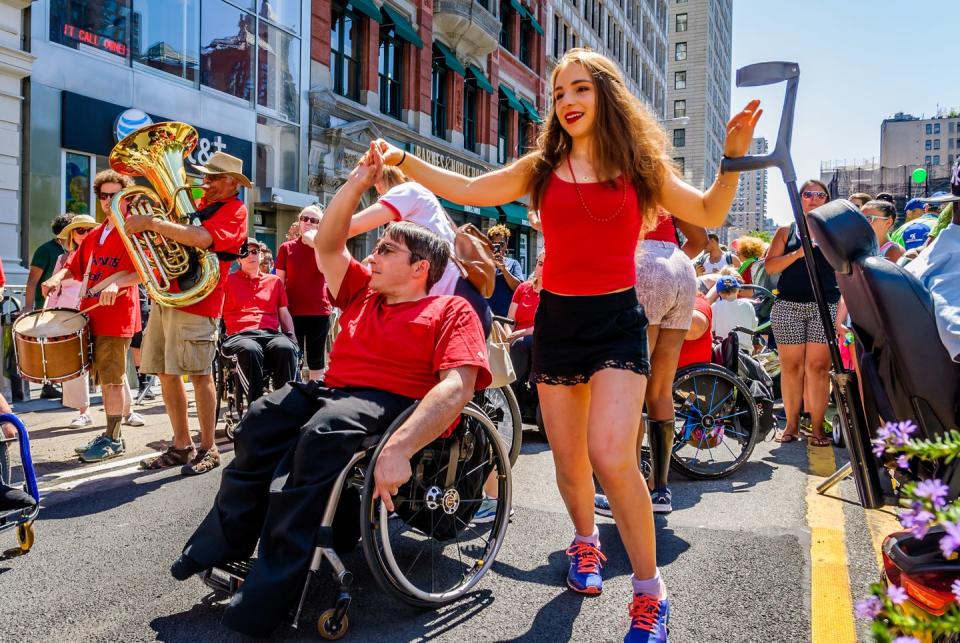Here's What to Know About the Disability Pride Flag Ahead of Disability Pride Month

Just as there are months dedicated to LGBTQ+ pride, Black history, and AAPI heritage, there is also a month dedicated to celebrating and advocating for the rights of disabled people. Additionally, there is a disability pride flag — which has an interesting origin story and an important meaning.
"Disability is a part of the rich tapestry of human diversity, and something that nearly all of us will experience at some point in our lives," explains Jackie Dilworth, communications director at The Arc of the United States, a disability rights organization. "It's also a significant identity that defines how we experience the world. Yet people with disabilities have been marginalized and misunderstood for generations."
According to the CDC, 27 percent of the US population has some kind of disability — that's one in four people. And as Dilworth notes, most people will experience being disabled at some point in their lives, whether temporarily or permanently. In other words, disability pride and improving accessibility should matter to everyone.
Similar to how there are Pride flags for different gender and sexual identities, there's also a disability pride flag. Keep reading to learn about the history of the disability pride flag and movement, as well as for ideas on how you can take action for Disability Pride Month in July.
What is the origin of the disability pride flag?
The original disability pride flag, which featured brightly colored zigzagging stripes over a black background, was created in 2019 by writer Ann Magill, who has cerebral palsy. As she explained in an interview on The Accessible Stall podcast, "My first design idea was to make the stripes zigzag, to represent how disabled people have to maneuver around all the barriers we face. We have to go this way and then we have to go that way, and then we have to go this way and then we have to go that way. And that’s how we move through the world."
However, it came to Magill's attention that when viewed on a phone or computer screen, the design was causing symptoms for individuals with visually triggered disabilities, including seizure and migraine disorders. (You can see the original flag here).
"I said, 'Okay, this is a mistake. How can we fix it? What if I made these changes?' And because I said, how can we fix this, and didn’t get upset and didn’t get possessive, people started anonymously offering suggestions," Magill shared with podcast hosts Kyle Khachadurian and Emily Ladau.
The redesigned version of the flag softens the colors and made the stripes straight instead of zigzagging. Magill also shared that the order of the stripes was changed to accommodate people with red-green colorblindness.

"I think it’s even better this way because it truly represents the community because the community came together to solve a problem," Magill shared.
What is the meaning of the disability pride flag?
In her interview with The Accessible Stall, Magill also shared what the colors on the disability flag represent.
The faded black background represents "the anger and mourning over the eugenics and the neglect that disabled people have to fight against."
Red represents physical disabilities.
Gold is for neurodiversity.
White represents invisible disabilities and disabilities that haven't yet been diagnosed.
Blue stands for emotional and psychiatric disabilities, including mental illness, anxiety, and depression.
Green is for sensory disabilities, including deafness, blindness, lack of smell, lack of taste, audio processing disorder, and all other sensory disabilities.
When is Disability Pride Month?
Disability Pride Month takes place in July. "July marks the anniversary of the Americans with Disabilities Act, landmark legislation that broke down barriers to inclusion in society," Dilworth tells Woman's Day. The Americans with Disabilities Act was passed July 26, 1990.
"But barriers still exist, which is why we need to unapologetically normalize disability, the people who experience and identify with it, and the wide range of supports they need to thrive," she explains.

How can I celebrate Disability Pride Month?
A good place to start would be looking to any disability advocacy organizations in your area. They may have information about parades, educational events, and other Disability Pride events happening in your community during the month of July. They'll also likely have plenty of ideas for other ways to celebrate Disability Pride Month, including volunteering, getting involved with advocacy efforts, and donating money to support those efforts. Some organizations to consider include The Arc, Diversability, The National Disability Rights Network, and The National Black Disability Coalition.
Advocating for the rights of disabled people in your community is also important. The Arc's website has an Action Center where you can contact your legislators about bills and programs that affect people with disabilities. You can also make it a point to attend public meetings in your area to advocate for things like improved accessibility in local schools, businesses, public facilities, and more. If there's a local disability advocacy group in your city or town, look to see what issues they're focusing on and offer your support.

You can also make sure that you're advocating for disabled people in your day-to-day life. For instance, you might think of ways your workplace, place of worship, or children's schools could be more accessible or inclusive for disabled people and share those thoughts with leadership teams.
You can also make it a point to shop at businesses that are owned and operated by disabled people or that donate a share of their proceeds to disability advocacy organizations. Lastly, you can do the work of educating yourself about the experiences of disabled people by reading books, listening to podcasts, watching interviews and speeches, and reading articles that address these topics.
You Might Also Like

